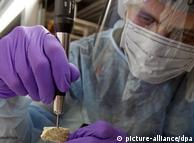Analysis has shown that Neanderthal DNA still lives on in modern
man, disproving the long-held belief that the more primitive homo
species never interbred with humans and had in fact died out some 30,000
years ago.
German scientists announced their findings on Friday in a paper
published in the US journal Science, which shows that between 1 and 4
percent of the DNA in people living in Europe, China and New Guinea has
Neanderthal origins. The rest is attributable to the main Homo sapiens
line with its roots in Africa. Previous laboratory tests had missed the
hard-to-find clues and assumed the two species forked 500,000 years ago,
never to rejoin.
Ralf W. Schmitz, a University of Bonn scientist who took part in the
study, said that now that they have uncovered the whole picture, they've
proven that Neanderthals are a part of our ancestry.
"This is an incredible breakthrough for paleogenetics, and incredible
breakthrough for archeology and for anthropology. This paper is an
absolute milestone," he told German television station ZDF.
 Bildunterschrift:
Researchers in Leipzig spent years analyzing data
Bildunterschrift:
Researchers in Leipzig spent years analyzing data
Living side by side
Historians have speculated that Homo sapiens and Homo
neanderthalensis hunter-gatherers made war with one another, but the
finding shows they made love too, and could have produced children. That
probably happened in the Middle East, where archaeological excavations
show the populations existed side by side between 80,000 and 50,000
years ago. The mixed children spread to Asia and Europe.
The finding comes from a first draft of the Neanderthal genome, using
partly rotted material from the bones of six individuals, sequenced at
the Max Planck Institute for Evolutionary Anthropology in Leipzig,
Germany.
 Bildunterschrift: Großansicht des Bildes
mit der Bildunterschrift: Though
some people may carry Neanderthal DNA, scientists say physical traits
are no longer visible
Bildunterschrift: Großansicht des Bildes
mit der Bildunterschrift: Though
some people may carry Neanderthal DNA, scientists say physical traits
are no longer visible
"More than 95 per cent of the DNA in the samples came from bacteria
and micro-organisms that had fed on the remains after the Neanderthals
died," said institute chief scientist Svante Paabo.
Past studies had concentrated only on mitochondrial DNA, a type where
no intermixing was found. "It was another surprise that even the
Chinese carry Neanderthal genes, although Neanderthals never lived in
China," said Schmitz.
Multiple bones examined
Neanderthal bones have been discovered down the years at 300 places
in Europe and Asia. The species was named after a valley, the
Neandertal, which lies in western Germany near the city of Dusseldorf,
where the first officially recognized bones were found by men digging in
a quarry in 1856.
The most famous collection of Neanderthal bones resides at the North
Rhine Westphalia state museum in the former German capital, Bonn. The
collection consists of 16 pieces, including a skull cap, two femurs,
three right arm bones and two left arm bones.
It was these bones, which have been carbon dated at 42,000 years old,
that supplied some of the genetic material examined by the scientists
in Leipzig. They also used samples from Croatia, the Caucasus and Spain,
dated from 42,000 to 70,000 years old.
 Bildunterschrift: Großansicht des Bildes
mit der Bildunterschrift: One
of the most famous collection of Neanderthal bones belongs to the
Landesmuseum in Bonn
Bildunterschrift: Großansicht des Bildes
mit der Bildunterschrift: One
of the most famous collection of Neanderthal bones belongs to the
Landesmuseum in Bonn
The youngest Neanderthal bones ever found were unearthed in the
United Kingdom and Croatia. All of these specimens were dated between
32,000 and 33,000 years old. No verifiable specimen has been found that
was younger than 30,000 years old, leading scientists to declare that to
be when they died out.
Of course the exact circumstances that led to humans reproducing with
Neanderthals are up for debate, though the scientists said they weren't
concerned with who was having sex with whom.
"What's interesting to me is how that influenced who I am today,"
said Paabo.
Author: Mark Mattox
Editor: Stuart Tiffen
http://www.dw-world.de/dw/article/0,,5551290,00.html









